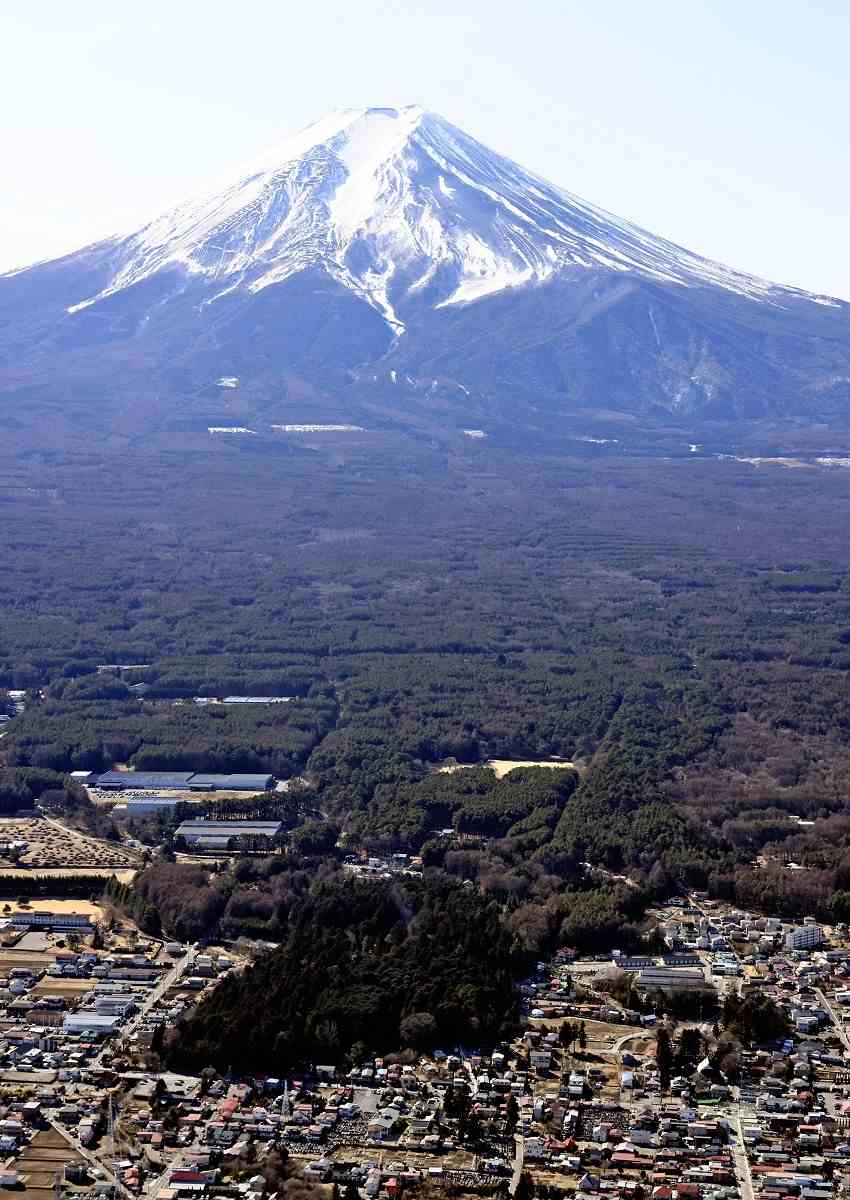
The Yoshida Trail, which stretches to the summit of Mt. Fuji from its starting point at Kitaguchi Hongu Fuji Sengen Jinja shrine in Fujiyoshida, Yamanashi Prefecture, is seen on Jan. 26.
14:45 JST, January 29, 2023
An ancient Mt. Fuji climbing route is set to be restored in a bid to revive the mountain’s reputation as a “sacred” location.
Most climbers who visit Japan’s tallest peak take the Yoshida Trail on the Yamanashi Prefecture side, starting from the fifth station, where there are shops and midway parking areas. However, the trail actually starts at the foot of the 3,776-meter mountain. But this section of the route has fallen out of favor over the years and its name has started to fade from collective memory.
To counter this trend, concerned locals and related entities plan to research the old path and improve its facilities, such as by repairing a run-down lodge and installing new lavatories. By doing so, it is hoped that summiting Mt. Fuji will become more pleasant and climbers will be able to appreciate anew the mountain’s cultural and historical importance.
Mt. Fuji will mark its 10th anniversary as a UNESCO World Heritage site in June.
The research — set to begin in the next fiscal year — will be led by the city government of Fujiyoshida, one of the localities at the foot of the mountain.
There are four major climbing routes on Mt. Fuji. The only route that starts at the foot of the mountain is the full Yoshida Trail, which runs 15-kilometers from the Kitaguchi Hongu Fuji Sengen Jinja shrine — 864 meters above sea level — to the peak.
Religious pilgrimages, called Fuji-ko, were among the factors that helped secure UNESCO status. Fuji-ko members — primarily commoners — believed Mt. Fuji was sacred and worthy of worship. The pilgrimages were most popular from the Edo period (1603-1867) to the Taisho era (1912-1926), and people from the Kanto region would frequently use the old route.
Mt. Fuji became a subject of worship partly because of its stately appearance and its repeated large-scale eruptions. These factors, too, were singled out when the mountain was registered as a World Heritage location.
When Fuji-ko was at its peak, numerous shrines, lodges and teahouses lined the routes from the mountain foot to the midpoint — an about 10-kilometer distance.
But after the 1964 opening of the Fuji-Subaru Line toll road which runs up the lower part of the mountain to the fifth station, it became common for climbers to start their ascent from the midpoint. It is still possible to ascend Fuji starting from its foot, but the city government found that only about 7,000 people passed Umagaeshi — near the foot of the mountain — during its opening period last year. This figure represents 6% of the climbers who passed the sixth station, which comes shortly after the midpoint.
Over the years, many of the old route’s shrines and lodges became run-down and fell out of use. For example, the Suzuhara-sha shrine building near the start of the trail, which enshrines the Dainichi Nyorai Buddhism deity, has become skewed, while the Inoue-goya mountain lodge near the midpoint, which closed in around 1980, has a hole in the roof.
In its heyday, the route boasted about 20 lodges where climbers could spend the night, but now, only one remains. Furthermore, the trail only has temporary lavatories. “It’s difficult for us to encourage people to come,” a local government official said.
The city government plans to research the old shrines and lodges, consult with their owners and compile an improvement plan in a two-year period from fiscal 2023.
The area around the trail is a national park, and the trail is managed by the Yamanashi prefectural government. As such, the city government will coordinate with the central and prefectural governments and consider such measures as reinforcing the buildings, establishing environment-friendly lavatories and building shelters for climbers to use when bad weather strikes.
With an eye on recapturing the look of bygone days, the city government intends to check whether it is possible to prune or fell certain trees along the route.
The Fujiyoshida city government hopes that its efforts will attract school excursions and foreign tourists, and plans to install signboards in shrines and other locations explaining the history behind the worshipping of Mt. Fuji.
The city government intends to begin its improvement work as early as fiscal 2024. To finance the project, it will utilize ¥50 million collected in donations and raise a further ¥200 million through a crowdfunding program under the Furusato Nozei framework, which allows people to make tax deductions in return for making donations to local governments.
“The improvements will allow people to rediscover Mt. Fuji’s value as a world-class mountain of faith and help increase its appeal,” said 60-year-old Atsushi Jomonji, chief priest at Kitaguchi Hongu Fuji Sengen Jinja shrine.
Related Tags
"Society" POPULAR ARTICLE
-

Tokyo Zoo Wolf Believed to Have Used Vegetation Growing on Wall to Climb, Escape; Animal Living Happily after Recapture
-

Israeli Tourists Refused Accommodation at Hotel in Japan’s Nagano Pref., Prompting Protest by Israeli Embassy and Probe by Prefecture
-

Tsukiji Market Urges Tourists to Avoid Visiting in Year-End
-

Snow Expected in Tokyo, Neighboring Prefectures from Jan. 2 Afternoon to Jan. 3; 5-Centimeter Snow Fall Expected in Hakone, Tama, and Chichibu Areas
-

Tokyo, Yokohama Observe First Snowfall of Season; 1 Day Earlier than Average Year
JN ACCESS RANKING
-

As Chinese Tourists Shun Japan, Hotels and Stores Suffer
-

Osaka-Kansai Expo’s Economic Impact Estimated at ¥3.6 Trillion, Takes Actual Visitor Numbers into Account
-

Japan Govt Adopts Measures to Curb Mega Solar Power Plant Projects Amid Environmental Concerns
-

BOJ Gov. Ueda: Highly Likely Mechanism for Rising Wages, Prices Will Be Maintained
-

Economic Security Panels Debate Supply Chains, Rare Earths; Participants Emphasize Importance of Cooperation Among Allies

























